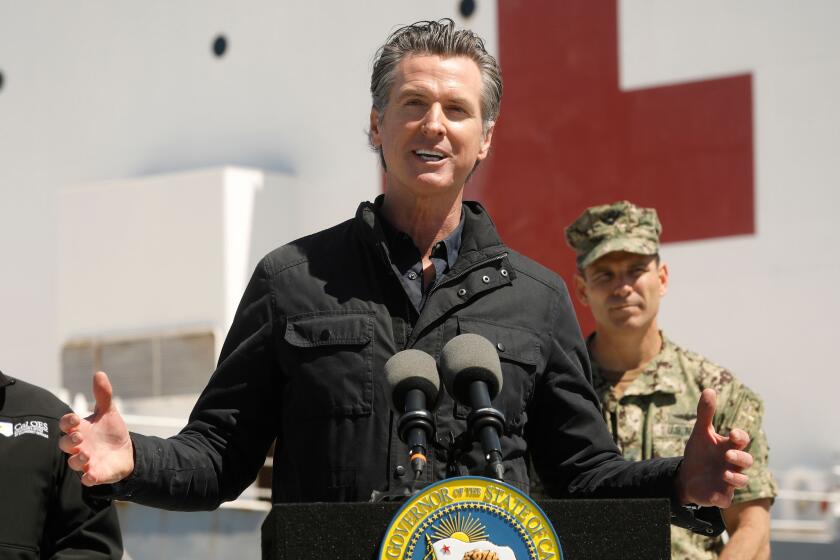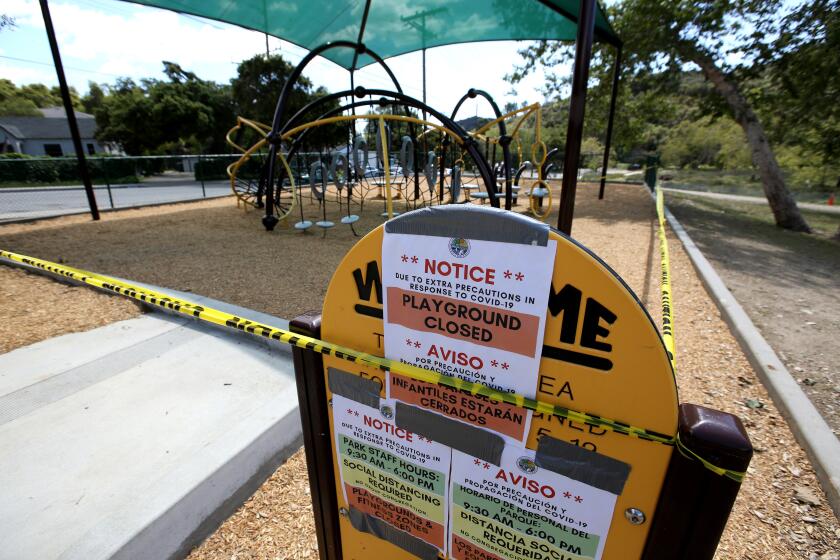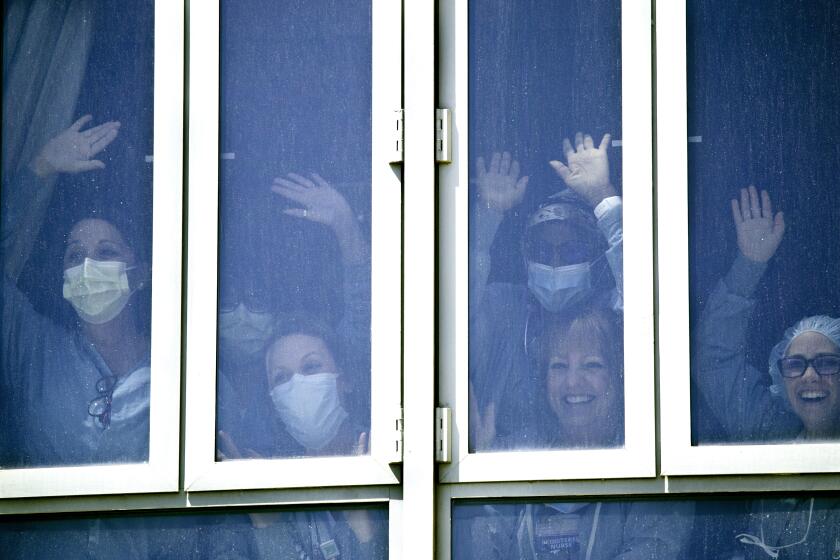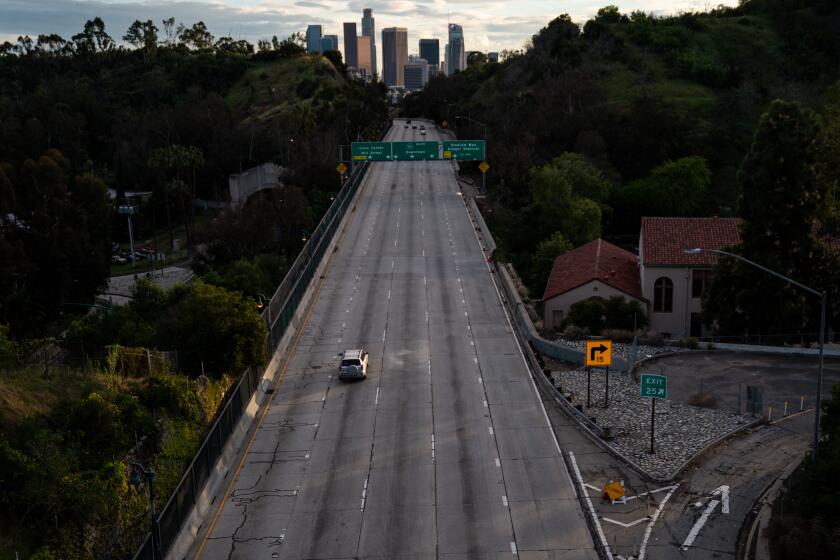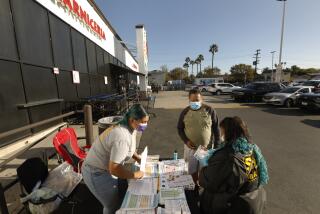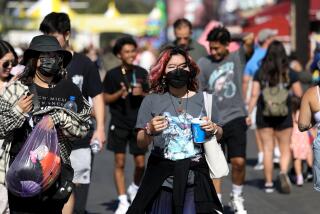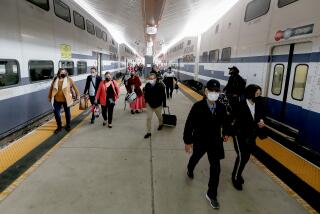L.A. County reports 42 more coronavirus deaths, a new single-day high
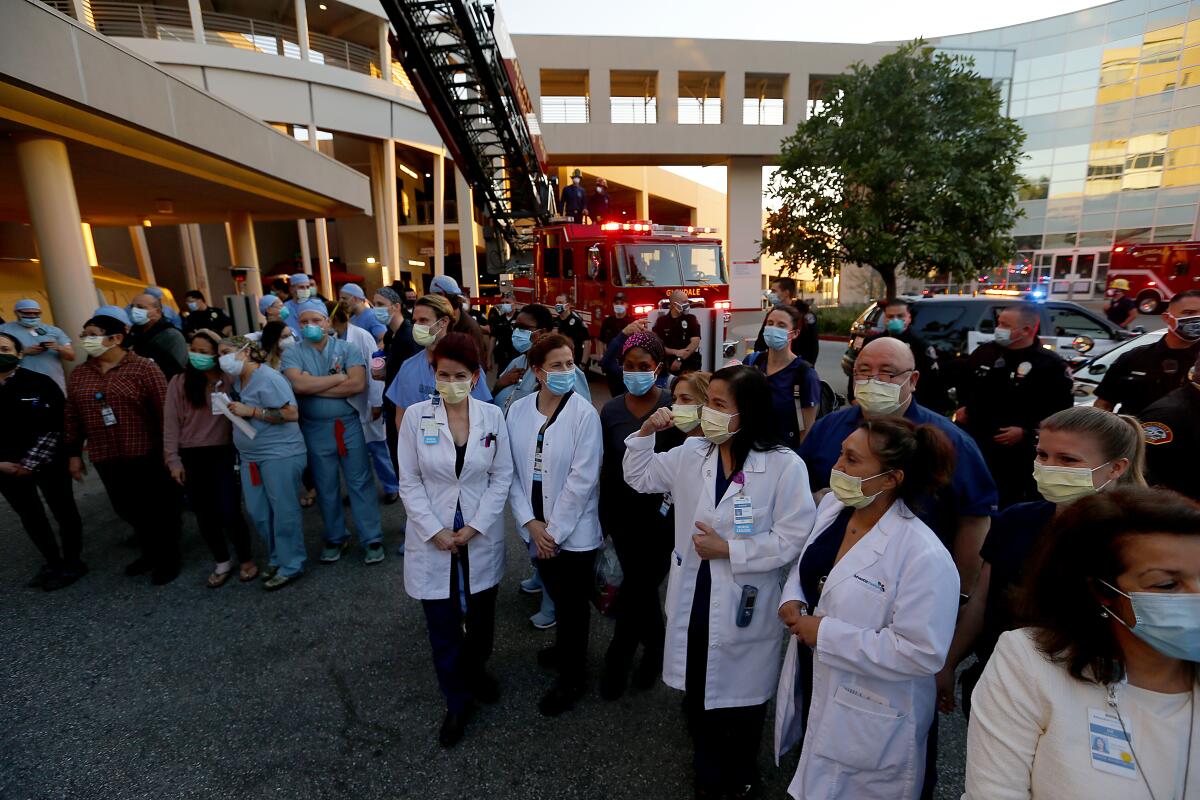
Los Angeles County health officials on Wednesday confirmed 42 more deaths linked to the coronavirus, the highest number reported in a single day, bringing the county’s death toll to 402.
Public Health Department Director Barbara Ferrer also confirmed 472 new COVID-19 cases, bringing the county’s total to nearly 10,500. Officials have previously said the case count includes people who have recovered, but there is no way to track those numbers.
Among the most recent deaths, 24 people were older than 65, 11 were ages 41 to 65 and one person was 18 to 40, Ferrer said. Information on the six other deaths wasn’t immediately available.
Here’s an inside look with doctors and nurses on the frontlines of the COVID-19 battle.
“These are now our worst two days back to back,” Mayor Eric Garcetti said during a news conference Wednesday evening, referencing Tuesday’s death toll of 40. “These are not statistics. These are stories.”
The county’s news comes after nearly a month of unprecedented social distancing efforts that have altered the lives of Californians. Public officials across the state this week have begun offering their insights as to when the restrictions may finally be eased.
A common theme appears to be emerging: Now is not the time to loosen stay-at-home orders.
Gov. Gavin Newsom on Tuesday said California needs to increase testing, protect high-risk residents from infection and expand hospital capacity before the state can begin to modify the stay-at-home order he imposed a month ago and gradually return to a sense of normalcy.
The parameters Newsom outlined suggest the state must meet a high bar before walking back the order.
California and its local governments are selective about what information they provide about the coronavirus crisis. What does the public have a right to know, and why is some information being held back?
“I want you to know it’s not, it will not be a permanent state,” he said. “We recognize the consequences of the stay-at-home orders have a profound impact on the economy, your personal household budget, your personal prospects around your future.”
It could be sometime in May before state and local officials begin to seriously contemplate how they might start to gradually ease the stay-at-home order.
“This is not the end, and it’s not even the beginning of the end, but perhaps the end of the beginning,” Anna Roth, director of Contra Costa Health Services, said Tuesday, quoting Winston Churchill’s comments after a victory in World War II in 1942. “Now is not the time for us to take a victory lap.”
Dr. Chris Farnitano, Contra Costa County’s health officer, went further. “It’s not even the end of the beginning. It’s still the beginning of the beginning in this crisis,” Farnitano told the county Board of Supervisors.
“If we do not continue our efforts to really reduce the spread within our community by our social-distancing and staying-at-home efforts ... we are still at risk of facing a surge that could overwhelm our hospitals,” he said.
In Los Angeles, Garcetti said, a key step toward lifting restrictions will be widespread, two-pronged testing — virology tests, which check whether you’re actively infected, and serology tests to detect whether you’ve been infected by the virus in the past.
The tests, he said, will help L.A. move “from crisis to recovery.”
California authorities are citing businesses that refuse to shut down as well as individuals visiting parks and beaches closed due to the coronavirus.
Managing outbreaks in long-term care facilities, where older patients with underlying health conditions are among the most vulnerable, remains a priority, Long Beach officials said Wednesday, noting that of the city’s 18 COVID-19 deaths, 13 have been associated with long-term care facilities. The city issued a new health order on Wednesday requiring that all staff and residents have their temperatures checked daily and mandating that staff wear surgical masks at all times.
In the Bay Area, which initially saw the largest concentration of cases statewide but has had success flattening the curve, officials on Wednesday doubled down on a message from last week: Don’t even think about packing together in public on 4/20.
The city’s legendary love fest to cannabis won’t be tolerated this year and the streets surrounding Golden Gate Park, where the event is held each year, will be fenced off, San Francisco Police Chief William Scott said during a news conference.
“If we have to cite, we will,” Scott said. “If we have to arrest, we will.”
California’s hospitals have not been stretched to the limit, as medical facilities have been in New York. As of Wednesday, California had reported 858 deaths, while New York state has reported more than 10,000. Over the last week, California has averaged 1,177 new cases and 48.3 new deaths per day.
Firefighters and law enforcement officers from L.A. to Laguna Beach express their gratitude to healthcare workers for their efforts in fighting COVID-19.
Daily coronavirus related deaths reached new heights in Los Angeles County this week. Health officials on Tuesday confirmed 40 deaths linked to the coronavirus, which before Wednesday, was the highest number reported in a single day.
The latest number of those infected includes 28 people in the homeless community. While the majority of those people were unsheltered, officials noted that six people who tested positive for COVID-19 were staying in a shelter. At least three of the cases were reported at the Union Rescue Mission on skid row.
Ferrer added that county health officials are “making sure everybody is appropriately isolated and quarantined” at the shelter.
She said officials are using daily data on countywide infections and deaths to make decisions about when to start relaxing social distancing requirements. She’s hopeful this could begin by the middle or end of May, but encouraged residents to continue their efforts, including wearing face coverings in public and staying home as much as possible, in the meantime.
“The sacrifices made cannot be counted: Some have lost loved ones, some have been ill, some have lost jobs, some have had to temporarily close business, some are guiding children through remote learning and everyone has had to live our day-to-day life very differently than we are used to,” Ferrer said. “Thank you for continuing to do what you’re doing. Engaging in these practices is making a difference, and we will get to the other side of this together.”
However, it may be quite a while before life as most Angelenos know it returns to normal.
An internal Los Angeles Fire Department email reviewed by The Times indicates that the city may hold off on allowing big gatherings, like concerts and sporting events, until 2021 because of the coronavirus threat. Mayor Eric Garcetti raised the issue during his weekly briefing Monday with a group of high-level staff from several departments, including Fire Chief Ralph Terrazas, according to the email.
Newsom and officials in his administration say their strategy to slow the spread of the virus is working, pointing to relatively low growth in COVID-19 hospitalizations as evidence that staying home and social distancing are preventing a surge of infections.
But that success comes with a cost.
More than 2.3 million Californians filed for unemployment benefits in the last month as businesses closed due to state mandates, and the economy continues to unravel. Some students lost access to free and reduced-cost meals when schools shuttered, and many have not participated in virtual learning. To meet a growing demand in L.A., Garcetti said Wednesday that the city plans to more than double the number of seniors receiving free meals several times a week from 5,000 to 12,000. And the governor’s strategy of distancing residents can also lead to social isolation and increased health risks for the elderly and vulnerable.
Despite his attempts to quell uncertainty, Newsom has not yet provided a timeline for when the state’s nearly 40 million people can expect to return to work — or move about freely. And to those struggling to make ends meet, that’s the question they want answered most.
New CDC study suggests people listened to officials as coronavirus restrictions on movement grew.
“When are the restrictions going to be lifted?” asked Miguel Tot, who last worked at his job managing a downtown Los Angeles restaurant on March 16. “There’s no timetable on that, so I have no idea, you know, when normality is going to come back.”
Times staff writers Marisa Gerber, Richard Winton, Colleen Shalby, Dakota Smith and Ben Welsh contributed to this report
More to Read
Sign up for Essential California
The most important California stories and recommendations in your inbox every morning.
You may occasionally receive promotional content from the Los Angeles Times.

